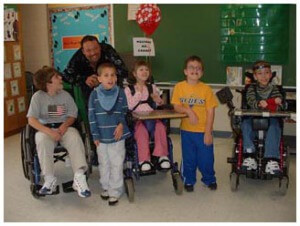 Whether you are currently teaching or looking into the teaching profession, you may have an interest in learning about teaching methods for students with physical disabilities. Even if you are not planning to focus on special education, the current inclusion of students with physical disabilities in many typical classrooms means that teachers of all kinds need to be familiar with teaching strategies that will be of help to their students who have special needs.
Whether you are currently teaching or looking into the teaching profession, you may have an interest in learning about teaching methods for students with physical disabilities. Even if you are not planning to focus on special education, the current inclusion of students with physical disabilities in many typical classrooms means that teachers of all kinds need to be familiar with teaching strategies that will be of help to their students who have special needs.
Inclusion in a Typical Classroom
When it comes to special education, you may be familiar with the older term mainstreaming, which referred to including a student with physical or other disabilities in a typical classroom. Today the more often used term is inclusion. There are some important differences between mainstreaming and inclusion. One difference is that in an inclusive class, students with special needs often have more paraprofessional help. They also may have different academic goals than their peers without physical disabilities. They will be assessed on these different academic goals, and there may be more focus on other learning goals, such as social or other life skills. The overall learning goals for a student with special needs may be different than goals for the other students in the class.
Accessible and Comfortable Classrooms
Once learning goals have been established, it will be up to the teacher, in conjunction with any paraprofessional help, to promote a good learning environment so that the student with disabilities can meet those goals. One way to do this is to ensure that the classroom, and everything in it, is arranged in ways that help students with disabilities have access to everything they need. Rather than having the student with disabilities off by themselves, teachers will typically arrange furniture and learning items in the classroom to maximize accessibility to all types of students. This may mean making use of low, open shelving, or assuring that at least some computer stations are arranged in a way to allow access to a student in a wheelchair, for example.
In addition to making sure special students can access what they need, it’s also important to educate the children in an inclusive classroom so that they understand the special needs of their peers. This can be handled in all sorts of ways, including sending information home with students about certain disabilities, or giving the students time to ask questions of a disabled peer, if the student feels comfortable answering them.
Making Use of Assistive Technology
In addition to thoughtful planning and preparation, teachers can make use of an abundance of assistive technology in today’s classrooms. These may include things like ergonomic writing aids, electronic keypads and transcription software. There are also special art tools made for children who need adaptive equipment. Teachers may need to become informed advocates in order to help districts obtain funding sources for such needed equipment.
The goal of any good teacher is to help students learn to the very best of their abilities. When those abilities are limited or challenged in some way, it can take extra thoughtful planning, preparation and use of resources to help students. Learning about teaching methods for students with physical disabilities will help teachers to do their very best for all the students in the classroom.




